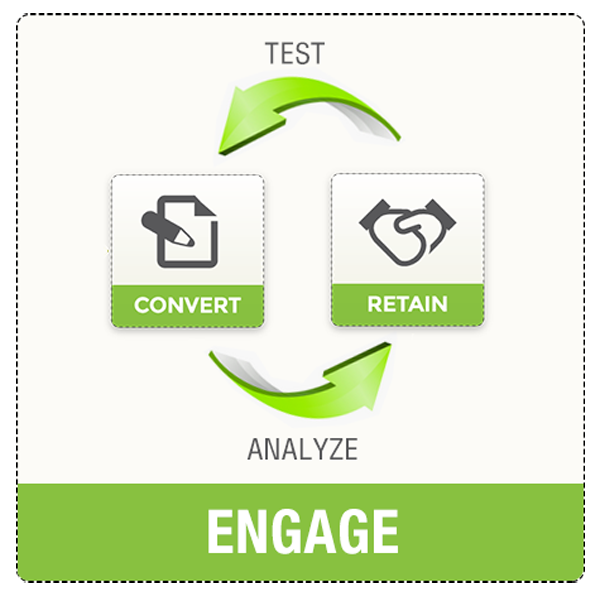Attract, Convert, Retain 2.0
The basic idea of lead generation has been the same thing for quite some time — and rightfully so, because it works. You attract a visitor to your site, convert them into a customer, then retain them for as long as possible (because it is cheaper to keep existing customers than get new ones). Unfortunately, […]
The basic idea of lead generation has been the same thing for quite some time — and rightfully so, because it works. You attract a visitor to your site, convert them into a customer, then retain them for as long as possible (because it is cheaper to keep existing customers than get new ones).

Unfortunately, this model is starting to show its age.
Problems With Attract, Convert & Retain
Looking at the history of lead generation (view infographic) over the years, the launch of the Internet continued to support this linear marketing model when the Web came on the scene.
Like radio, TV and print, websites and banners are still one-way marketing. But mobile and social media have caused a big shift from the one-sided marketing pitch to a peer influenced strategy, with the real power being in the network of voices talking about a given product or service.
As a marketing technologist, I’ve been a big believer in the above model for a long time. It has generated a lot of leads for me and my customers alike. But “attract, convert, retain” is still a linear system, and marketing is anything but linear these days. For instance:
1. Social Media Is Killing Direct Marketing. Friends invite one another to use an online service with what they have at their disposal such as email, social networks and text messaging. Conversations are digital, but outside any centralized control. Users are attracted more by the referral than a given feature set. It’s why so many services will see a mad rush of users only to collapse a few months later because, as it turns out, the product doesn’t deliver real value.
2. People Are No Longer Very Loyal. They go where their friends are as long as it is innovative or cool to use. Pricing influences the masses, but free is generally king right now for online services. If you have to have an awesome product that has to be free (or close to it) to compete in the market, then the business model is nothing like it used to be. Attracting and retaining a customer base goes way beyond discounts, controlling churn rates and good customer service.
3. Interaction Is Two-Way. Because successful product marketing must embrace social interaction, the relationship is critical. This requires a one-to-many as well as a one-to-one communication strategy. The user/buyer can become much more invested in the success of a product if the company engages with them. But being silent online is the same thing as ignoring your spouse — it will get you in hot water real quick.
The New Conversion Model Is About Engagement
“Attract, Convert, Retain” is still the foundation of all activity, but it was really never meant to be that simple. It must be an adaptive process that takes its own feedback (good and bad) to improve over time.
I believe that social and mobile media have actually made this conversion strategy even more valuable, as long as it evolves for your business as well. So let’s look at a slightly less linear version:

In this model, the core focus is on Visitor Engagement. When you’re engaged with an audience (customers, prospects, influencers, researchers), you are producing content and interacting with them on a continual basis.
Engagement replaces “Attract” because it is inherent in every step of the process. Your digital activity is constantly attracting visitors because it is social and shareable no matter what step of the marketing funnel a person is in.
This engagement strategy is a powerful feedback loop that you use to learn more about visitor needs, based on how they engage with your brand. This positively influences your “convert” and “retain” activity because they are tied together within the loop.
What Does Adopting This Strategy Do For Your Business?
1. Improves SEO. Increasing your interaction and communication in social media gets people talking. They share your content, and they will talk about you on their own blogs. All of this can help to improve your search engine rankings.
2. Increased Conversions. More people that know about your brand and enjoy interacting with you will drive an improvement in your conversion rates.
3. Builds Brand Loyalty. As you become a knowledge leader that people trust to provide great content and respond promptly, they will generally become increasingly loyal. This is key to building awareness and keeping out the knockoff competitors.
4. Leverages The Community. If your loyal followers increase, they will spread the word. It’s amazing how far people will go to support the brands they love.
Your Key To Success With Engage (Convert & Retain)
A key to the whole process is what goes on behind the scenes. The Visitor Engagement process requires continual user analysis and user testing through the entire journey. Just as adaptive web design is a continual process for improving user experience, engagement is a continual process of increasing positive brand awareness.
You have to know how people are responding, relative to your goals, to changes you make in communication and design. Only by doing that will you gain insights to constantly improve in all steps of the engagement process.
Contributing authors are invited to create content for MarTech and are chosen for their expertise and contribution to the martech community. Our contributors work under the oversight of the editorial staff and contributions are checked for quality and relevance to our readers. MarTech is owned by Semrush. Contributor was not asked to make any direct or indirect mentions of Semrush. The opinions they express are their own.
Related stories
New on MarTech